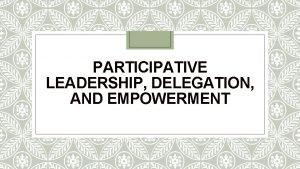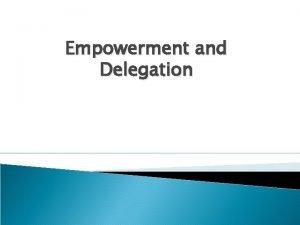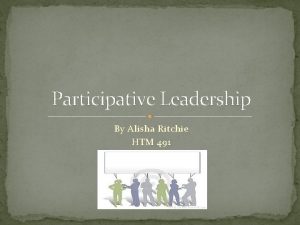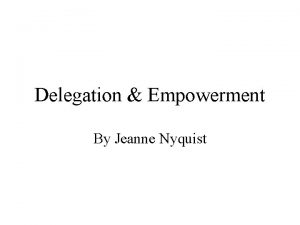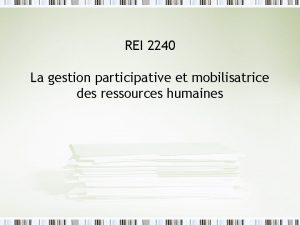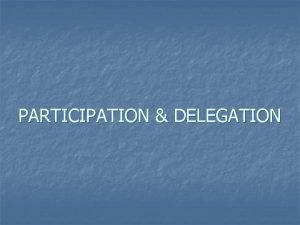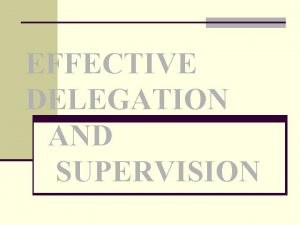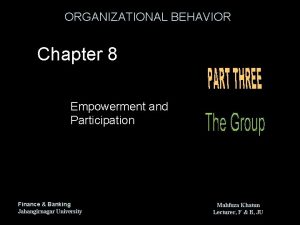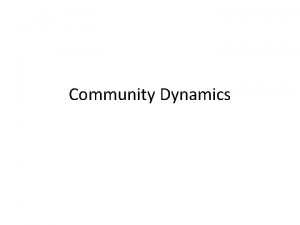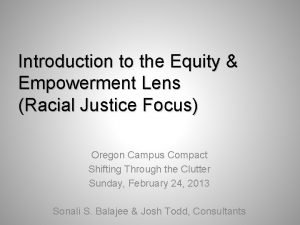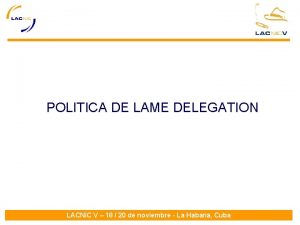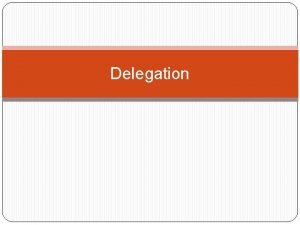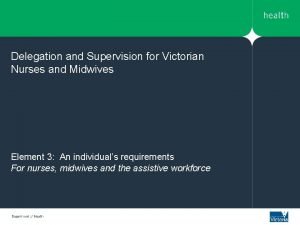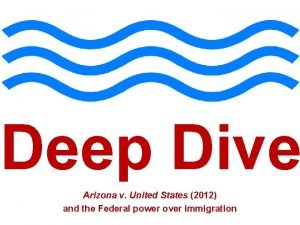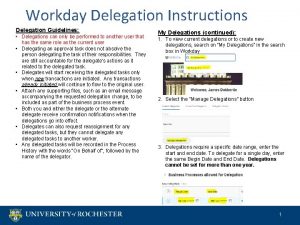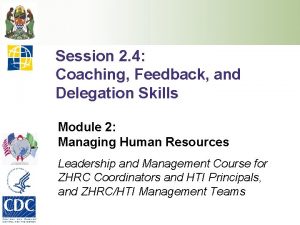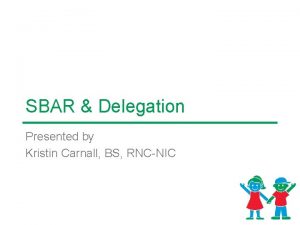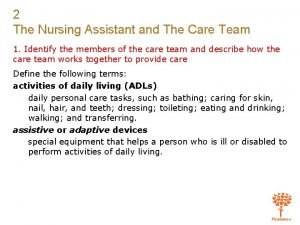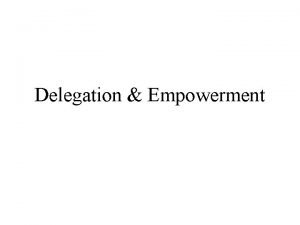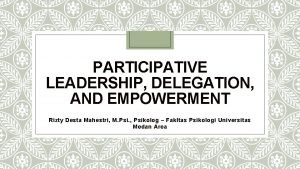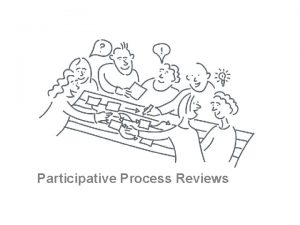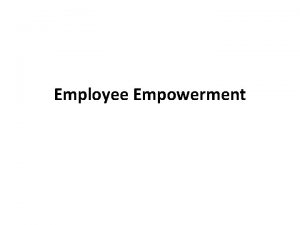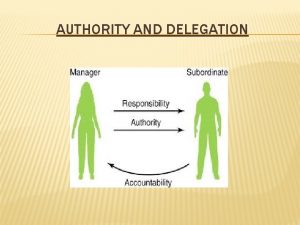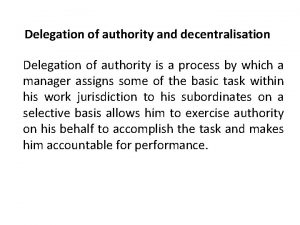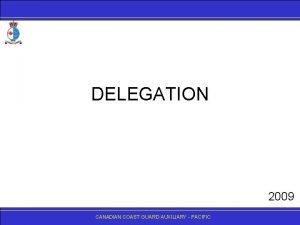Chapter 4 Participative Leadership Delegation and Empowerment Lectured











































- Slides: 43

Chapter 4 Participative Leadership, Delegation, and Empowerment Lectured by Dr. Tan Saroeun, NUM Copyright © 2010 Pearson Education, Inc. publishing as Prentice Hall Leadership in Organizations 4 -1

Copyright © 2010 Pearson Education, Inc. publishing as Prentice Hall Leadership in Organizations 4 -2

Learning Objectives Understand what research methods have been used to study participative leadership Understand the major findings in research on consequences of participative leadership Understand the situations in which participative leadership is most likely to be effective Understand the major findings in research on the normative theory of Copyright © 2010 Pearson Education, Inc. Leadership in Organizations 4 -3 leader decision making publishing as Prentice Hall

Learning Objectives (Cont. ) Understand procedures for the effective use of consultation Understand the potential benefits and risks of delegation Understand when and how to use delegation effectively Understand why follower perceptions of empowerment are important Copyright © 2010 Pearson Education, Inc. publishing as Prentice Hall Leadership in Organizations 4 -4

Varieties of Participation Autocratic Decision Consultation Joint Decision Delegation Copyright © 2010 Pearson Education, Inc. publishing as Prentice Hall Leadership in Organizations 4 -5

1. Autocratic Decision The manager makes a decision alone without asking for the opinions or suggestions of other people, and these people have no direct influence on the decision; there is no participation. Gñk. RKb; RKge. FVIkars. Merc. Etmñak; Ég eday Kµankars. Yrna. M Ts. Sn³BIGñkdéT nig Gñke. RkambgÁab; minman T§i. Bldl; kars. MerccitþNam. Yy nigminmankarc. Ulr. Ym. BI Copyright © 2010 Pearson Education, Inc. publishing as Prentice Hall Leadership in Organizations 4 -6

Example The United States’ Presidency must personally be more responsible for the country than anybody. Nobody can make a decision instead of the President. During his important decisions, to be a President of the United States thus is very lonely. Rb. Fana. Fibt. IRt. Uv. Et. TTYlxus. Rt. Uv. Cagnr. Na. Ta. Mg. Gs; s. Mrab; Rbe. Ts Cati. Kµannr. Na. Gace. FVIkars. MerccitþCMn. Ys. Rb. Fana. Fibt. I)ane. T. kñúg. GMLúge. Blkars. Merccitþ ta. Mgnam. Ca. Rb. Fana. Fibt. Ishrdæmñak; man. GarmµN_ fake. Nþac k. ENþgxøa. Mg. Nas; . Copyright © 2010 Pearson Education, Inc. publishing as Prentice Hall Leadership in Organizations 4 -7

2. Consultation The manager asks other people for their opinions and ideas, then makes the decision alone after seriously considering their suggestions and concerns. Gñk. RKb; RKgs. Yrna. MGñke. RkambgÁab; BITs. Sn³ KMnit bnÞab; mke. TIbe. FVIkars. Merccitþmñak; Ég Cae. RkaybnÞab; BIBicar. Nakar. ENna. Mnigb. Baðarbs; Gñke. R Copyright © 2010 Pearson Education, Inc. publishing as Prentice Hall Leadership in Organizations 4 -8

3. Joint Decision The manager meets with others to discuss the decision problem and make a decision together; the manager has no more influence over the final decision than any other participant. Gñk. RKb; RKg. CYb. Rb. CMu. Cam. Yy. Gñ kdéTed. Im, I Bi. Pak. Sab. Baðanig e. FVIkars. Merccitþr. Ym. Kña. Gñk. RKb; RKg Copyright © 2010 Pearson Education, Inc. publishing as Prentice Hall Leadership in Organizations 4 -9

4. Delegation The manager gives an individual or group the authority and responsibility for making a decision; the manager usually specifies limits within which the final choice must fall, and Prior approval may or may not be required before the decision can be implemented. Gñk. RKb; RKgpþl; e. Gaybu. KÁlb¤Rkumn. Uv. G MNac nig kar. TTYlxus. Rt. Uvs. Mrab; kare. FVIkars. Merccitþ. Gñk. RKb; RKg. Ca. TUe. TA k. MNt; RBMEdn. Cak; c, as; kñúgkars. Merccitþ Copyright © 2010 Pearson Education, Inc. publishing as Prentice Hall Leadership in Organizations 4 -10

Consequences of Participative Leadership Copyright © 2010 Pearson Education, Inc. publishing as Prentice Hall Leadership in Organizations 4 -11

Consequences of Participative Leadership (Cont. ) Potential Benefits of Participation Decision quality Decision acceptance Satisfaction with the decision process Development of participant skills Objectives of Different Participants Copyright © 2010 Pearson Education, Inc. publishing as Prentice Hall Leadership in Organizations 4 -12

1. Decision Quality Increase the quality of a decision when participants have information and knowledge lacked by the leader and are willing to cooperate in finding a good solution to decision problem. Gñkc. Ulr. Ymman. B½t’mannigc. Me. N Hdwg. Edl. Gñkdwkna. Mx. VHxatnigm anqnÞHshkarkñúg karrkd. Me. Na. HRsayl¥ Copyright © 2010 Pearson Education, Inc. publishing as Prentice Hall Leadership in Organizations 4 -13

2. Decision Acceptance People who have considerable influence in making a decision tend to identify with it and perceive it to be their decision. mnus. SEdlmanT§i. Blxag. Rti. Hri. Hkñúgka re. FVIkars. Merccitþ man. TMenar. Ka. MRTkars. Merccitþ nigyl; dwg. BIvaed. Im, Ie. TACa kars. Merccitþrbs; e. K. Copyright © 2010 Pearson Education, Inc. publishing as Prentice Hall Leadership in Organizations 4 -14

2. Decision Acceptance (Cont’d) Participation also provides a better understanding of the nature of the decision problem and the reasons why a particular alternative was accepted and others rejected. karc. Ulr. Ym)anpþl; pg. Edrn. Uvkaryl; dwg BIlkçN³én b. Baðakars. Merccitþe. Gay)an. Rbes. Irni g ehtupl. Edl CMer. Isd¾ Cak; lak; Rt. Uv. TTYlsÁal; Copyright © 2010 Pearson Education, Inc. publishing as Prentice Hall Leadership in Organizations 4 -15

2. Decision Acceptance (cont. ) Participants gain a better understanding of how they will be affected by a decision, which is likely to reduce any unwarranted fears and anxieties about it. karc. Ulr. Yms. Merc)an karyl; dwgkan; Et. Rbes. Ir. BIrebob. Edl. BYk e. KrgT§i. Bledaykars. MerccitþEdl. TMn g. Cakat; bnßykar. Py½xøac. Kµansi. T§G MNac nig Pa. BGnÞHsar. GMBIva. Copyright © 2010 Pearson Education, Inc. publishing as Prentice Hall Leadership in Organizations 4 -16

3. Satisfaction with the Decision Process The opportunity to express opinions and preferences before a decision is made (voice) can have beneficial effects regardless of the amount of actual influence participants have over the final decision (choice). » kased. Im, Is. MEdg. Ts. Sn³nigc. MNg; c. MNUlci tþmunkar s. Merccitþ Rt. Uve. FVI ¬eh. Afa s. Me. Lg¦ Gacmanl. T§pld¾man. Rbeya. Cn_ eday min. Kit. BIc. Mn. Yn. Gñkc. Ulr. Ym. Cak; Esþge. TA el. Ikars. Merc citþcuge. Rkay ¬eh. Afa CMer. Is¦. Copyright © 2010 Pearson Education, Inc. publishing as Prentice Hall Leadership in Organizations 4 -17

4. Development of Participant Skills The experience of helping to make a complex decision can result in the development of more skill and confidence by participants. b. TBiesa. Fn_én kar. CYye. FVIkars. MerccitþsµúKsµaj. Ga c pþl; l. T§pldl; kar. GPiv. DÆCMnaj nig Pa. Be. COCak; b. Enßm Copyright © 2010 Pearson Education, Inc. publishing as Prentice Hall Leadership in Organizations 4 -18

Research on Effects of Participative Leadership Example of Research on Participation – Bragg & Andrews (1973) Effects of Participation Limitations of Participation Research Measurement problems with survey field research Combining interventions Short-term programs Difficulty comparing results across studies Copyright © 2010 Pearson Education, Inc. publishing as Prentice Hall Leadership in Organizations 4 -19

Normative Decision Model Vroom and Yetton Model Decision Procedures AI – Leader makes decision without any additional information AII – Leader seeks information and makes decision alone CI – Leader shares problem with others individually and makes decision alone CII – Leader shares problem with others collectively and makes decision alone GII – Group discusses problem collectively and the group makes the decision Copyright © 2010 Pearson Education, Inc. publishing as Prentice Hall Leadership in Organizations 4 -20

Normative Decision Model Vroom and Yetton Model (Cont. ) Copyright © 2010 Pearson Education, Inc. publishing as Prentice Hall Leadership in Organizations 4 -21

Normative Decision Model Vroom and Yetton Model (Cont. ) Situational Variables 1. The amount of relevant information possessed by leader and subordinates 2. The likelihood that subordinates will accept an autocratic decision 3. The likelihood that subordinates will cooperate if allowed to participate 4. The amount of disagreement among subordinates with respect to preferred alternatives 5. The extent to which the decision is unstructured and requires creative problem solving Copyright © 2010 Pearson Education, Inc. Leadership in Organizations 4 -22 publishing as Prentice Hall

Normative Decision Model Vroom and Yetton Model (Cont. ) Decision Acceptance – Degree of commitment to implement a decision effectively Decision Quality – Objective aspects of the decision that affect group performance aside from any effects mediated by decision acceptance Copyright © 2010 Pearson Education, Inc. publishing as Prentice Hall Leadership in Organizations 4 -23

Normative Decision Model Vroom and Yetton Model (Cont. ) Copyright © 2010 Pearson Education, Inc. publishing as Prentice Hall Leadership in Organizations 4 -24

Normative Decision Model Vroom and Jago Model Incorporates additional aspects of the situation Incorporates additional outcome criteria Severe time constraints Amount of subordinate information Geographical dispersion of subordinates Concern for subordinate development Concern for decision time Managers given more choices in setting priorities for the criteria in the model Allows managers to differentiate among five choices in describing the situation Copyright © 2010 Pearson Education, Inc. publishing as Prentice Hall Leadership in Organizations 4 -25

Normative Decision Model Simplified Version Copyright © 2010 Pearson Education, Inc. publishing as Prentice Hall Leadership in Organizations 4 -26

Normative Decision Model Vroom and Yetton Model (Cont. ) Research on the Model Some support but more research needed Extended model needs to be tested Conceptual Weaknesses Decision processes are treated as single, discrete episodes The model is too complicated Leaders are assumed to have necessary skills to use the various decision procedures Copyright © 2010 Pearson Education, Inc. publishing as Prentice Hall Leadership in Organizations 4 -27

Guidelines for Participative Leadership Diagnosing Decision Situations Evaluate how important the decision is Identify people with relevant knowledge or expertise Evaluate likely cooperation by participants Evaluate likely acceptance without participation Evaluate whether it is feasible to hold a meeting Copyright © 2010 Pearson Education, Inc. publishing as Prentice Hall Leadership in Organizations 4 -28

Guidelines for Participative Leadership (Cont. ) Encourage Participation Encourage people to express their concerns Describe a proposal as tentative Record ideas and suggestions Look for ways to build on ideas and suggestions Be tactful in expressing concerns about a suggestion Listen to dissenting views without getting defensive Try to utilize suggestions and deal with concerns Copyright © 2010 Pearson Education, Inc. Leadership in Organizations 4 -29 Hall Show appreciation for suggestions publishing as Prentice

Delegation Varieties of Delegation Potential Advantages of Delegation Improvement in decision quality Greater subordinate commitment Making subordinates’ jobs more interesting, challenging, and meaningful Improved time management Important form of management development Copyright © 2010 Pearson Education, Inc. publishing as Prentice Hall Leadership in Organizations 4 -30

Potential Advantages of Delegation Copyright © 2010 Pearson Education, Inc. publishing as Prentice Hall Leadership in Organizations 4 -31

Delegation (Cont. ) Reasons for Lack of Delegation Aspects of the leader’s personality Fear of subordinate making a mistake High need for personal achievement Characteristics of the subordinate Nature of the work Copyright © 2010 Pearson Education, Inc. publishing as Prentice Hall Leadership in Organizations 4 -32

Reasons for Lack of Delegation Copyright © 2010 Pearson Education, Inc. publishing as Prentice Hall Leadership in Organizations 4 -33

Guidelines for Delegation What to Delegate Tasks that can be done better by a subordinate Tasks that are urgent but not high priority Tasks relevant to a subordinate’s career Tasks of appropriate difficulty Both pleasant and unpleasant tasks Tasks not central to the manager’s role Copyright © 2010 Pearson Education, Inc. publishing as Prentice Hall Leadership in Organizations 4 -34

Guidelines for Delegation (Cont. ) How to Delegate Specify responsibilities clearly Provide adequate authority and specify limits of discretion Specify reporting requirements Ensure subordinate acceptance of responsibilities Copyright © 2010 Pearson Education, Inc. publishing as Prentice Hall Leadership in Organizations 4 -35

Delegation (Cont. ) How to Manage Delegation Inform others who need to know Monitor progress in appropriate ways Arrange for the subordinate to receive necessary information Provide support and assistance, but avoid reverse delegation Make mistakes a learning experience Copyright © 2010 Pearson Education, Inc. publishing as Prentice Hall Leadership in Organizations 4 -36

Perceived Empowerment Nature of Psychological Empowerment describes how the intrinsic motivation and self-efficacy of people are influenced by leadership behavior, job characteristics, organization structure, and their own needs and values. kar. Rb. Kl; GMNacxag citþsa. Rsþ BN’narebobkarel. Ik. TWkcitþxagkñúg nig Rbsi. T§Pa. Brbs; bu. KÁlikxøÜnÉg Rt. Uv. CHTi§Bledayriyabf. Pa. BCa. Gñk dwkna. Mbu. KÁliklkçN³kargarrcnasm<n§½én. Gg ÁPa. B nig t. Mr. Uvkar nig t. Mél Copyright © 2010 Pearson Education, Inc. publishing as Prentice Hall Leadership in Organizations 4 -37

Perceived Empowerment Programs Leader Selection and Assessment Democratic Decision Procedures Shared Leadership Responsibilities Copyright © 2010 Pearson Education, Inc. publishing as Prentice Hall Leadership in Organizations 4 -38

Consequences of Empowerment Benefits Stronger task commitment Greater initiative in carrying out role responsibilities Greater persistence in the face of obstacles and temporary setbacks More innovation and learning Higher job satisfaction Stronger organizational commitment Less turnover Copyright © 2010 Pearson Education, Inc. publishing as Prentice Hall Leadership in Organizations 4 -39

Consequences of Empowerment (Cont. ) Costs and Risks Higher costs for selection and training Higher labor costs for skilled employees Inconsistent service quality Expensive giveaways and bad decisions by some employees Customer feeling's of inequity about unequal treatment Opposition by middle managers who feel threatened Conflicts from raising employee expectations beyond what top management Copyright © 2010 Pearson Education, Inc. Leadership in Organizations 4 -40 is willing to concede publishing as Prentice Hall

Conditions Facilitating Psychological Empowerment Copyright © 2010 Pearson Education, Inc. publishing as Prentice Hall Leadership in Organizations 4 -41

Guidelines for Empowerment Copyright © 2010 Pearson Education, Inc. publishing as Prentice Hall Leadership in Organizations 4 -42

All rights reserved. No part of this publication may be reproduced, stored in a retrieval system, or transmitted, in any form or by any means, electronic, mechanical, photocopying, recording, or otherwise, without the prior written permission of the publisher. Printed in the United States of America. Copyright © 2010 Pearson Education, Inc. publishing as Prentice Hall Leadership in Organizations 4 -43
 Participative leadership and empowerment
Participative leadership and empowerment Leadership delegation and empowerment
Leadership delegation and empowerment Delegation vs empowerment
Delegation vs empowerment Participative leadership definition
Participative leadership definition Delegation & empowerment
Delegation & empowerment 5 rights of delegation nursing australia
5 rights of delegation nursing australia Cvintetul metoda
Cvintetul metoda Modèle de gestion participative
Modèle de gestion participative Transactional vs transformational leadership
Transactional vs transformational leadership Participation continuum
Participation continuum Elements of delegation
Elements of delegation Empowerment and participation in organizational behavior
Empowerment and participation in organizational behavior What are community dynamics
What are community dynamics Equity and empowerment lens
Equity and empowerment lens Trauma recovery and empowerment model
Trauma recovery and empowerment model Equity and empowerment lens
Equity and empowerment lens Adaptive leadership style
Adaptive leadership style Situational leadership vs adaptive leadership
Situational leadership vs adaptive leadership Dshs nurse delegation forms
Dshs nurse delegation forms Delegation matrix
Delegation matrix Lame delegation
Lame delegation Delegation event
Delegation event Delegation pflegerischer tätigkeiten beispiele
Delegation pflegerischer tätigkeiten beispiele Delegation of authority framework
Delegation of authority framework 5 rights of delegation nursing examples
5 rights of delegation nursing examples 5 rights of supervision
5 rights of supervision Non delegation doctrine
Non delegation doctrine Non delegation doctrine
Non delegation doctrine Medication delegation
Medication delegation Advantages of delegation
Advantages of delegation How to delegate tasks in workday
How to delegate tasks in workday Coaching objectives
Coaching objectives 5 rights of delegation nursing examples
5 rights of delegation nursing examples Subordinate legislation in india
Subordinate legislation in india Reverse dns delegation
Reverse dns delegation Objective of delegation
Objective of delegation Objective of delegation
Objective of delegation Objectives of delegation
Objectives of delegation Kerberos delegation sql server
Kerberos delegation sql server Delegation of authority
Delegation of authority The nursing assistant and the care team chapter 2
The nursing assistant and the care team chapter 2 Callback vs delegate
Callback vs delegate Art of delegation training
Art of delegation training Organisation du ministère de la santé
Organisation du ministère de la santé
